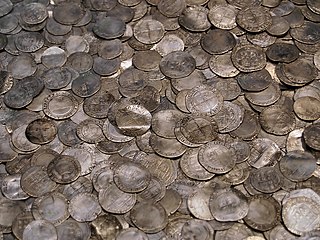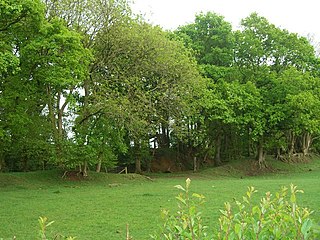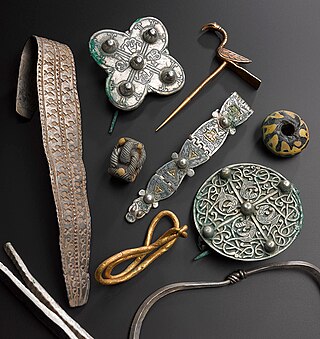List of hoards may refer to:
List of hoards may refer to:

A torc, also spelled torq or torque, is a large rigid or stiff neck ring in metal, made either as a single piece or from strands twisted together. The great majority are open at the front, although some have hook and ring closures and a few have mortice and tenon locking catches to close them. Many seem designed for near-permanent wear and would have been difficult to remove.

A hoard or "wealth deposit" is an archaeological term for a collection of valuable objects or artifacts, sometimes purposely buried in the ground, in which case it is sometimes also known as a cache. This would usually be with the intention of later recovery by the hoarder; hoarders sometimes died or were unable to return for other reasons before retrieving the hoard, and these surviving hoards might then be uncovered much later by metal detector hobbyists, members of the public, and archaeologists.

Wickham Market is a large village and electoral ward situated in the River Deben valley of Suffolk, England, within the Suffolk Coastal heritage area.

Stanwick Iron Age Fortifications, a huge Iron Age hill fort, sometimes but not always considered an oppidum, comprising over 9 kilometres (5.6 mi) of ditches and ramparts enclosing approximately 300 hectares of land, are situated in Richmondshire, North Yorkshire, England. Whether Stanwick was the stronghold of Venutius or Cartimandua, or perhaps of them both for a brief time before their acrimonious split some time after 51 AD, it is certain that this settlement was one of the most important in Brigantia, the Brigantes kingdom during the early stages of the Roman occupation of Britain. The site is a scheduled monument.



Zsujta is a village in Borsod-Abaúj-Zemplén county, Hungary. A large Bronze Age hoard of weapons and cart fittings, was discovered at the village in the late 19th century. The hoard is now in the collections of the British Museum, London.

Forró is a village in Borsod-Abaúj-Zemplén County in northeastern Hungary. As of 2008, the village had a population of 2,459. A large Bronze Age hoard was discovered at the village in the 19th century. The treasure is now in the collections of the British Museum, London.




Castle Rings is a univallate hill fort in the parish of Donhead St Mary in Wiltshire, England. The site is a Scheduled Ancient Monument. Castle Rings has been dated to the Iron Age and is at an altitude of 228 metres (748 ft) upon Upper Greensand sandstone beds. The bulk of the fort enclosure lies within the boundaries of Donhead St Mary parish but some of the outlying earthworks are in the neighbouring Sedgehill and Semley parish. In the mid-1980s a metal detectorist unearthed a hoard of stater coins of the Durotriges tribe within the hill fort.

The Galloway Hoard, currently held in the National Museum of Scotland, is a hoard of more than 100 gold, silver, glass, crystal, stone, and earthen objects from the Viking Age discovered in the historical county of Kirkcudbrightshire in Dumfries and Galloway in Scotland in September 2014. Found on Church of Scotland land, the hoard has been described by experts as "one of the most significant Viking hoards ever found in Scotland". With years of extensive study and research, scholars are still not certain who buried the hoard, why they did so and whether they were Vikings or Anglo-Saxons. During the Viking Age, Galloway found itself squeezed between two Viking kingdoms and essentially cut off from other Anglo-Saxons in Britain - "Galloway is where these different cultures were meeting. It’s not just Scandinavians, but people from Britain and Ireland as well."